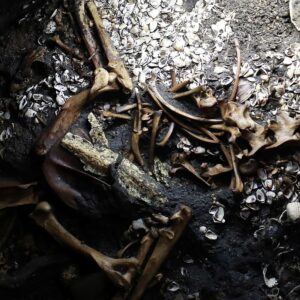Scientists are about to reconstruct the face of a woman who was killed in the 18th century for being a “witch” and subjected to a vampire burial. By creating a 3D model of the woman’s skull, a team of researchers in Poland hope to show what she would have looked like at the time of her death in the late 1700s.
The skeleton of the woman was discovered by archaeologists in 2014. At the time, researchers believed it to be the body of a man who became known as the vampire of Kamień. A piece of brick had been placed in the mouth of the skeleton and stakes had been driven through the legs.

Medieval and post-medieval “anti-vampiric” burials are found across Europe, with graves having been discovered at sites across Poland, Bulgaria and Italy. It is thought people believed that they could take preventative measures to stop the deceased from rising from the grave.
Along with placing a brick in the mouth, other techniques include placing a sickle over their necks, which would decapitate them if they tried to escape, and weighing their bodies down with stones.

Scientists at the Pomeranian Medical University in Szczecin have carried out genetic and forensic analysis of the Kamień skeleton and say the body belonged to a woman who was at least 65 when she died. She was about 5ft 6 tall and had blond hair and blue eyes, reports Science in Poland (PAP), a site run by the country’s Ministry of Science and Higher Education.
They say the injuries to the body were sustained while she was still alive and that she likely died from them. They believe she was accused of being a witch then tortured—with the leg piercing being part of this. Her accusers are believed to have placed a brick in her mouth to ensure “protection” from her black magic—even after her death, PAP reports.
Witch trials are known to have taken place in Poland across the Medieval period, with the last taking place around the end of the 18th century.

The team from the Pomeranian Medical University plan to use their 3D model of the woman’s skull to create a reconstruction of her face. There is a lot of interest in the appearance of this person” Andrzej Ossowski, head of the Forensic Genetics Unit at the university, told PAP.
He said they plan to make a virtual reconstruction as well as a 3D model, which will be built with layers of plastic material representing the soft tissue. They are planning to unveil the woman’s face in a few months.
“We want to show that with the help of modern methods, we are able to replace skeletons that are very common in museums with 3D models based on research,” Ossowski said. “I think that in the future, we should not display human remains in museums, especially that we already have the technology to replace them with models.”





